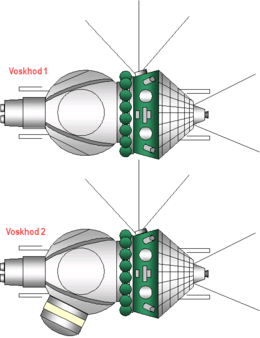Kosmos 57
Kosmos 57 was an unmanned Soviet Spacecraft launched on 22 February 1965.[1] The craft was essentially an unmanned version of Voskhod 2. Its primary mission was to test the Volga airlock. The test was successful, but the craft was lost shortly after. The Spaceflight is designated under the Kosmos system, placed with many other Soviet scientific and military satellites.
-

Vostok
-

Voskhod 1 and 2
-

Voskhod 2,
Airlock and spacesuit
Description
- Mass: 5682.0 kg [2]
Mission
The unmanned craft was launched three weeks before Voskhod 2. The primary objective of Voskhod 2 was to conduct a spacewalk, which relied on the inflatable Volga airlock. Kosmos 57 was to test the performance of the airlock. The airlock opened and closed successfully and the craft was re-pressurized without flaw.[3]
Orbital Parameters
| Parameter | Value |
|---|---|
| Periapsis | 165 km |
| Apoapsis | 427 km |
| Period | 91.1 minutes |
| Inclination | 64.8° |
| Eccentricity | 0.01961 |
Destruction
The unmanned spacecraft was destroyed on its third orbit around Earth. Two ground control stations, one in Klyuchi and the other in Yelisovo, sent simultaneous commands instructing the craft to depressurize its airlock. The craft interpreted this as an order to begin descent and a propulsion error put the craft into a tumble. Approximately twenty-nine minutes later the craft's automatic self-destruct function activated. The craft was completely destroyed to prevent sensitive information from literally falling into enemy hands. Over 100 pieces of the spacecraft were tracked, falling into the ocean between 31 March and 6 April 1965.[4]
See also
- List of Kosmos satellites
- Overview at Encyclopaedia britannica
- Spacecraft launches in 1965, Overview
References
- ↑ Baker, David (1996). Spaceflight and Rocketry. United States of America: Facts on File Inc. p. 176. ISBN 0-8160-1853-7.
- 1 2 NASA notice
- ↑ Evans, Ben (2009). Escaping the Bonds of Earth. Chichester, UK: Praxis Publishing. p. 196. ISBN 978-0-387-79093-0.
- ↑ Hall, Rex; Shayler, David (2001). The Rocket Men, Vostok and Voskhod, the First Soviet Manned Spaceflights. Chichester, UK: Praxis Publishing. p. 243. ISBN 1-85233-391-X.